Overview
If you're struggling with arthritis and seeking disability benefits, we understand how overwhelming this process can feel. It's essential to thoroughly document how your condition affects your daily activities. By following the specific application criteria set by the Social Security Administration (SSA), you can improve your chances of approval.
Providing comprehensive medical documentation is vital. Detail your functional limitations and understand the SSA’s evaluation process. This can significantly enhance your likelihood of approval, especially considering the high rate of initial claim denials. Remember, you are not alone in this journey; we're here to help you navigate these challenges.
Introduction
Arthritis affects millions, and yet many remain unaware of its potential to qualify for disability benefits. We understand that joint disorders like osteoarthritis and rheumatoid arthritis can severely limit daily activities and work capabilities. Therefore, understanding the nuances of the application process is crucial.
What steps can you take to enhance your chances of receiving the support you need amidst the complexities of the Social Security Administration's criteria and the high rate of initial claim denials?
It's common to feel overwhelmed by the process, but you're not alone in this journey. With the right information and guidance, you can navigate the system more effectively.
Let's explore how you can improve your chances of success and find the assistance you deserve.
Understand Arthritis and Its Implications for Disability Benefits
Joint disorders encompass over 100 different types, with osteoarthritis and rheumatoid conditions being among the most prevalent. We understand that the impact of joint inflammation on daily life can be profound, especially regarding the chances of getting disability for arthritis. The Social Security Administration (SSA) acknowledges that joint inflammation can be a potentially disabling condition, which may influence the chances of getting disability for arthritis, especially when it significantly restricts a person's ability to perform essential work tasks. For example, approximately 1.5 million individuals in the U.S. live with rheumatoid joint disease, which can lead to debilitating fatigue, joint stiffness, and mobility limitations. These symptoms can interfere with daily activities, ultimately affecting one’s overall quality of life.
When preparing your impairment application, it is vital to document how joint inflammation affects your mobility and ability to engage in everyday activities, as this can impact your chances of getting disability for arthritis. The SSA assesses the severity of your condition and its impact on daily functioning, which includes evaluating the chances of getting disability for arthritis based on your residual functional capacity (RFC). For instance, individuals with a 60% impairment rating may encounter considerable challenges, such as being unable to bend their elbow past a certain angle or experiencing ongoing pain that prevents them from working.
Practical examples illustrate the hurdles faced by individuals grappling with joint inflammation as they navigate the benefits system. Many applicants encounter initial denials, with nearly 70% of first-time claims being rejected. However, those who thoroughly document their condition and its effects on their daily lives often enhance their chances of getting disability for arthritis upon appeal. Staying informed about changes in Social Security policies and collecting comprehensive medical documentation can significantly enhance your chances of approval.
In summary, joint inflammation can have a substantial impact on your everyday life, making it essential to clearly articulate these effects in your application for assistance. By understanding the implications of your condition and effectively documenting its effects, you can increase your chances of getting disability for arthritis. Remember, you are not alone in this journey, and we’re here to help you every step of the way.
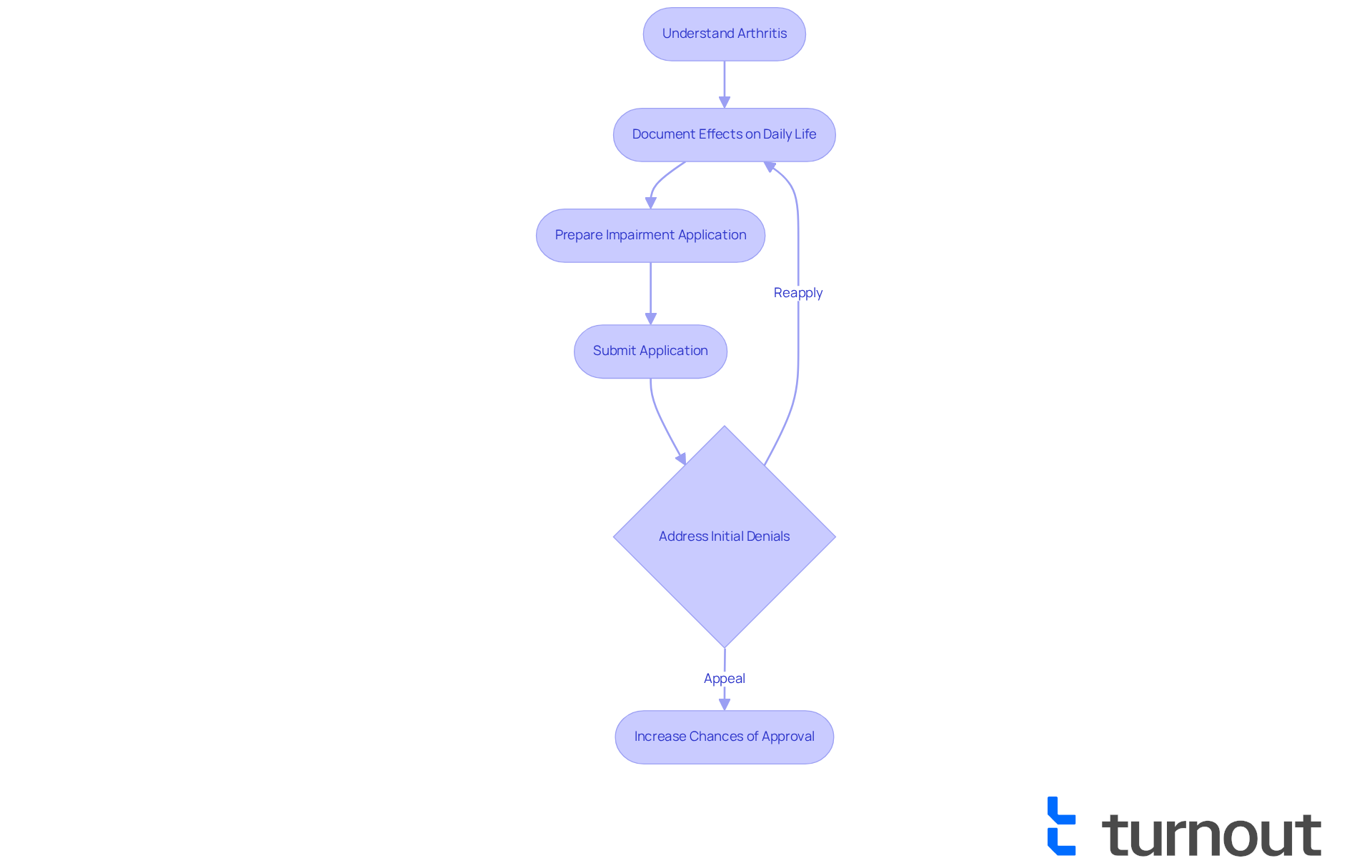
Determine Eligibility Criteria for Disability Benefits
To qualify for disability benefits due to joint inflammation, it’s important to understand the chances of getting disability for arthritis based on the specific criteria set by the Social Security Administration (SSA). We know that navigating this process can be overwhelming, but demonstrating that your joint condition significantly limits your ability to work is essential. The SSA evaluates your situation based on several key factors:
-
Medical Documentation: Comprehensive medical evidence is crucial. This includes a verified diagnosis, treatment history, test results, and detailed physician notes that describe the severity of your joint condition. Strong documentation can greatly influence the outcome of your claim.
-
Functional Limitations: You must show how your joint condition limits your ability to perform everyday tasks. This includes difficulties in walking, standing, lifting, or using your hands. The SSA looks for clear evidence of how these limitations affect your work-related capabilities.
-
Duration of Condition: Your joint inflammation must have lasted, or be expected to last, for at least 12 months. This requirement highlights the need for ongoing medical treatment and documentation to support your claim.
-
Residual Functional Capacity (RFC): Even if you do not meet the SSA's specific listings, you may still qualify for benefits based on your RFC, which describes what you can do physically and mentally at work despite your limitations.
Understanding these criteria is vital for assessing your chances of getting disability for arthritis and effectively guiding your documentation efforts. Joint inflammation is among the most frequently granted conditions for assistance benefits, with musculoskeletal disorders often recognized by the SSA. It’s common to feel discouraged, especially considering that recent statistics indicate around 35% of initial support requests are accepted, while nearly two-thirds are rejected. This highlights the challenges many applicants face. Additionally, the SSA's evaluation process may include updates to medical-vocational guidelines, reflecting modern job market conditions and medical advancements, which could impact your claim.
Turnout offers valuable assistance in navigating these complex processes, utilizing trained nonlawyer advocates to help you prepare your SSD claims effectively. As Mary Anne Dunkin noted, "Applying for assistance due to arthritis can be a lengthy and challenging process, but patience and perseverance can yield rewards." By ensuring that your submission aligns with these criteria and leveraging Turnout's support, you can enhance your chances of getting disability for arthritis benefits. Remember, you are not alone in this journey; we’re here to help.
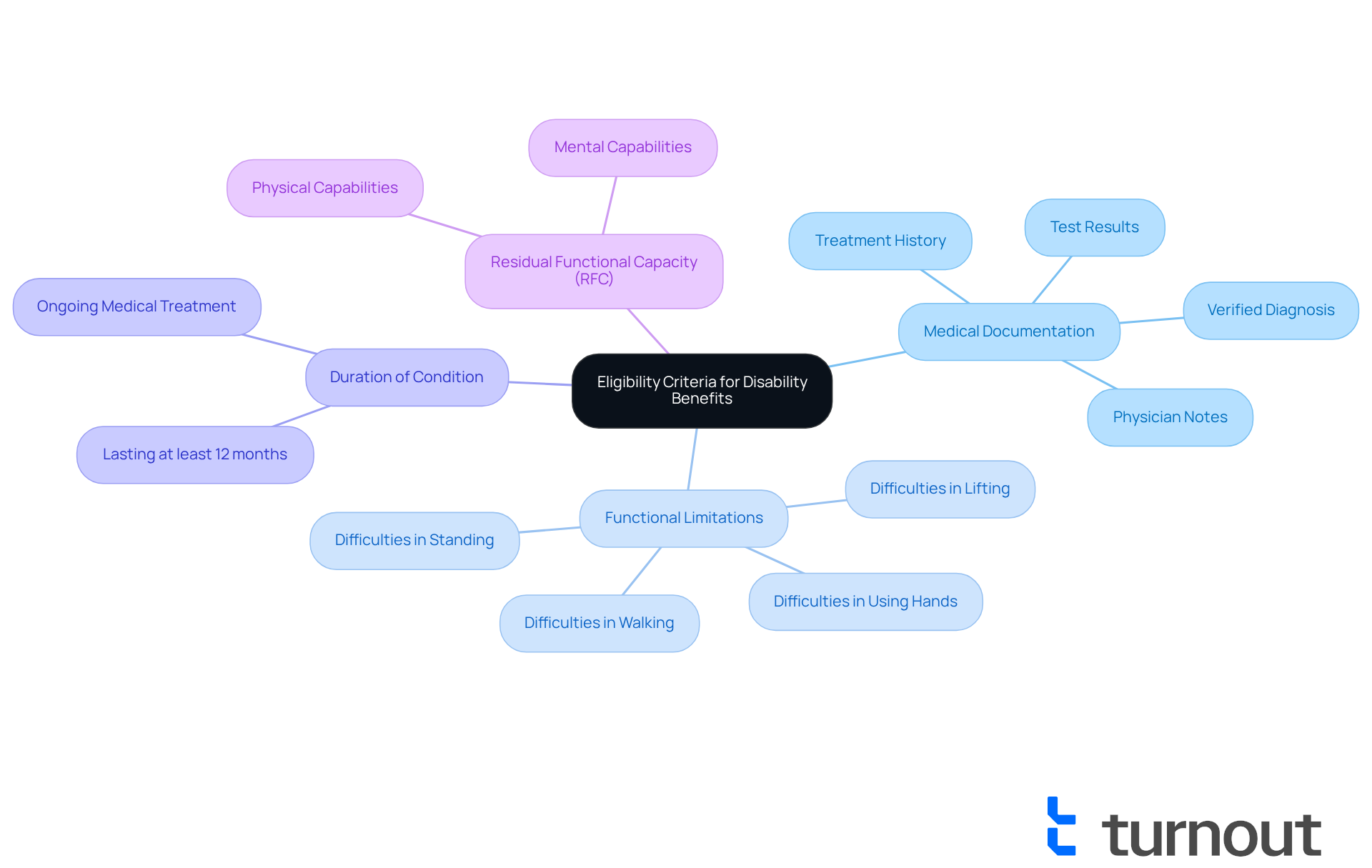
Gather Necessary Documentation for Your Application
Gathering the necessary documentation is vital for a successful disability benefits application. We understand that this process can feel overwhelming, but we’re here to help you every step of the way. Here’s what you need to collect:
-
Medical Records: Obtain copies of your medical records that detail your diagnosis, treatment history, and any relevant test results. Consistency in these records is crucial, as gaps or contradictory information can undermine your claim.
-
Physician Statements: Secure statements from your healthcare providers that detail your condition, treatment plan, and how the joint affliction impacts your daily activities. These statements should clearly articulate the limitations imposed by your condition, as they play a significant role in the evaluation process.
-
Work History: Compile a detailed work history that includes job titles, responsibilities, and how your condition has impacted your ability to perform these tasks. This documentation helps demonstrate the practical effects of joint inflammation on your work life.
-
Personal Statements: Write a personal statement describing how arthritis affects your life, including daily challenges and limitations. This narrative can offer valuable context to your submission, emphasizing the real-world implications of your condition.
-
Additional Evidence: Consider including any other relevant documents, such as physical therapy records or reports from specialists. Possessing a thorough collection of documents will enhance your submission.
Turnout is here to assist you in navigating this process. Our trained nonlawyer advocates can help ensure that your documentation is thorough and well-organized, which will enhance your chances of getting disability for arthritis. Please note that Turnout is not a law firm and does not provide legal advice. Remember, you are not alone in this journey; we are here to support you.
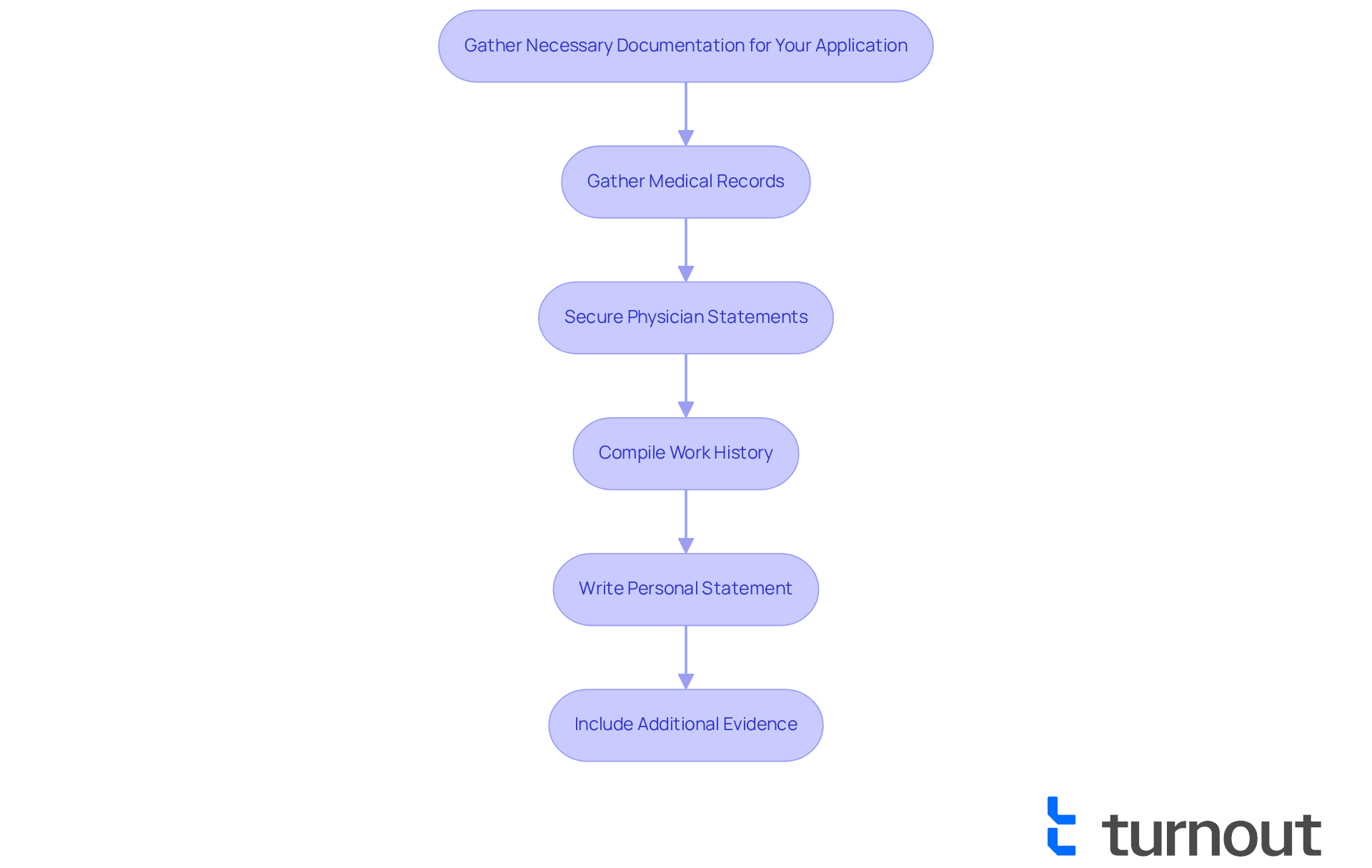
Complete the Application Process for Disability Benefits
Completing the application for disability benefits can feel overwhelming, but we're here to help you through it. Follow these key steps to make the process smoother:
-
Choose Your Application Method: You have options—apply online through the SSA website, by phone, or in person at your local SSA office. Select the method that feels most comfortable for you.
-
Fill Out the Application: Take your time to provide accurate and detailed information about your medical condition, work history, and how arthritis impacts your daily life to improve your chances of getting disability for arthritis. Honesty and thoroughness are essential, as the SSA evaluates claims based on the severity and effects of your condition.
-
Submit Your Documentation: Gather all necessary documentation from the previous step and attach it to your application. Ensure everything is organized and clearly labeled. Strong medical records are vital, as they support your claims and validate your condition.
-
Follow Up: After sending your request, keep track of its status. You can easily check online or contact the SSA for updates. If they request additional information, be prepared to provide it, as this can help speed up the review process.
-
Be Patient: We understand that waiting can be challenging. The review process may take several months, with average wait times for new applicants reaching around 225 days as of November 2023. Stay informed, and be ready to respond to any inquiries from the SSA—proactive communication can help you navigate potential delays.
By following these steps and ensuring your submission is thorough and well-documented, you can enhance your chances of getting disability for arthritis. Remember, you are not alone in this journey, and we’re here to support you every step of the way.
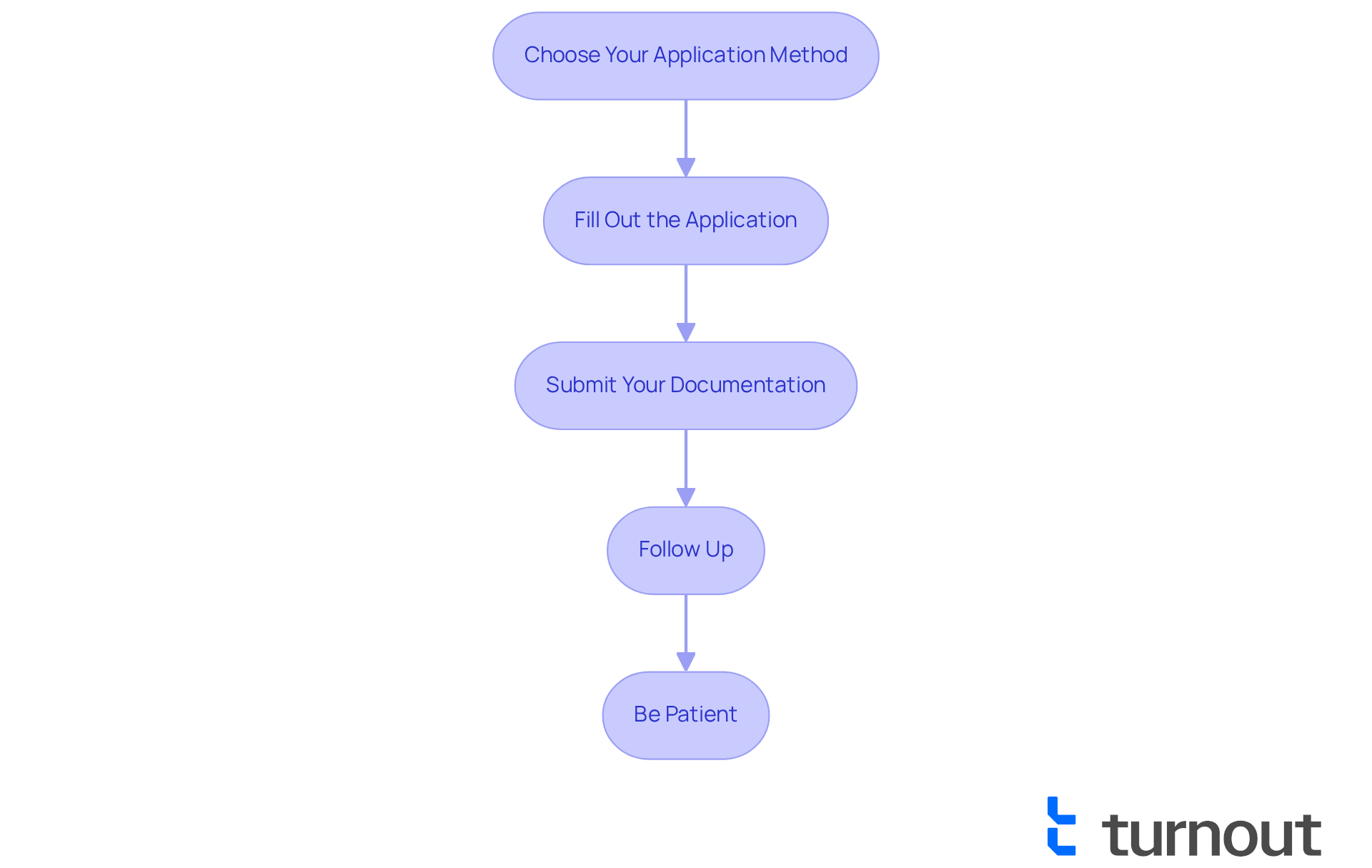
Troubleshoot Common Issues in the Application Process
Even with thorough preparation, we understand that candidates may face challenges during the submission process. Here are some common issues and compassionate strategies to address them:
-
Incomplete Submissions: It's essential to ensure that every section of your form is filled out completely. Lacking information can lead to delays or refusals, with around 70% of initial SSDI and SSI requests being rejected due to incomplete submissions. Remember, we’re here to help you through this.
-
Insufficient Documentation: If the Social Security Administration (SSA) requests additional documentation, respond promptly and provide the necessary information. Keeping copies of everything you send is crucial for your records. You are not alone in this; we can assist you in organizing your documents.
-
Denial of Benefits: If your request is denied, don’t be discouraged. You have the right to appeal the decision. Carefully review the denial letter to understand the reasons for denial, and gather additional evidence to strengthen your case. Keep in mind that around 35% of initial requests were accepted in 2022, making persistence essential. Turnout can support you in this process by offering trained nonlegal advocates who can help you navigate the intricacies of your submission. It’s important to note that Turnout is not a law firm and does not provide legal advice.
-
Long Wait Times: If you experience long wait times for a decision, consider contacting the SSA for updates. While patience is essential, staying proactive can help keep your case moving. In 2025, hearings will take place at one of 167 offices across the country, with wait times varying significantly by location. We understand that this can be frustrating, and we encourage you to reach out for support.
-
Seek Support: If you feel overwhelmed, consider reaching out to Turnout for assistance. Our trained advocates can provide guidance and support throughout the process, helping you navigate the complexities of your application and improve your chances of success. Remember, you are not alone in this journey; we’re here to help.
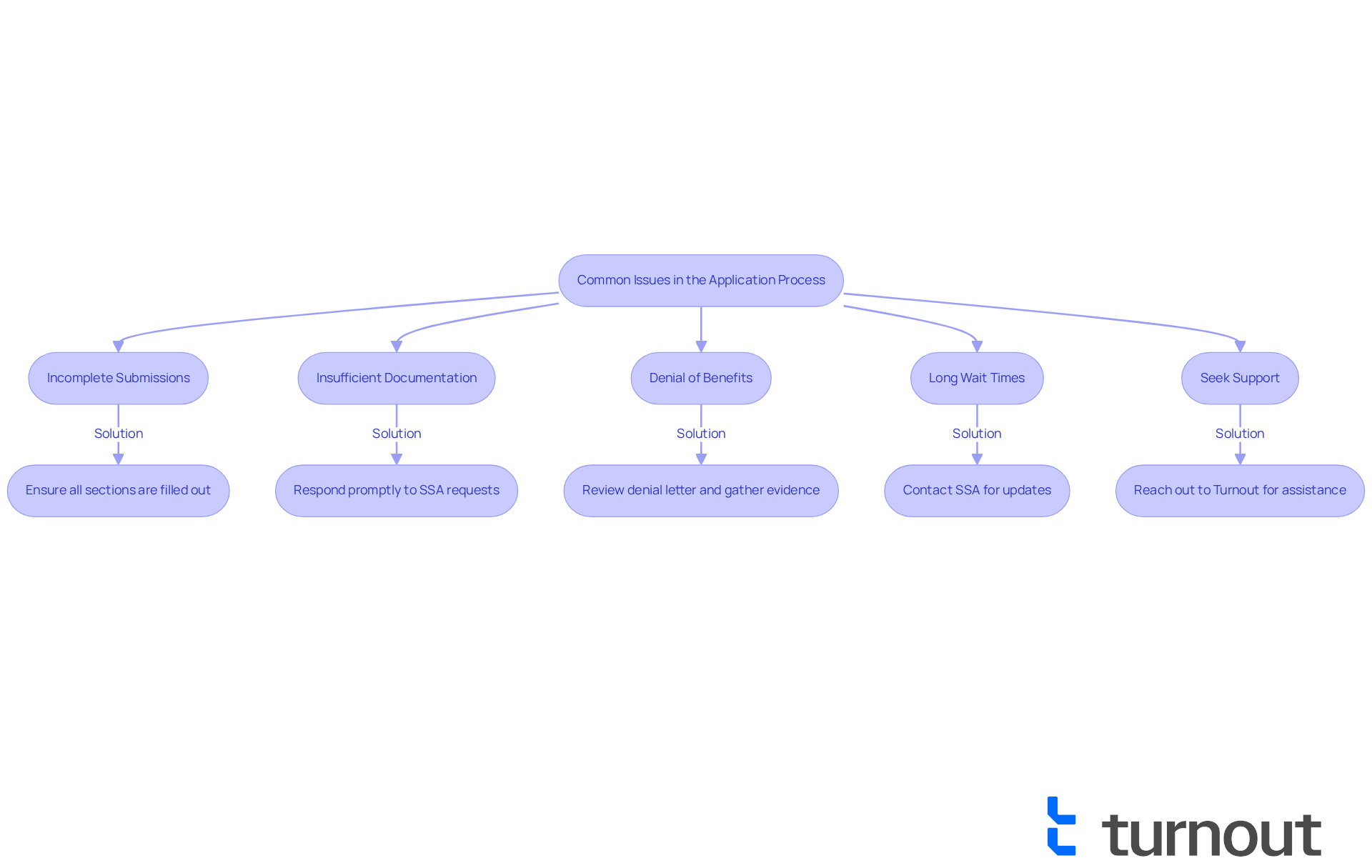
Conclusion
Understanding the complexities of obtaining disability benefits for arthritis is crucial for those affected by this debilitating condition. We recognize how challenging this journey can be. By effectively articulating how arthritis impacts daily life and work capabilities, you can significantly improve your chances of securing the necessary support.
Key strategies include:
- Gathering comprehensive medical documentation
- Clearly outlining your functional limitations
- Understanding the eligibility criteria set by the Social Security Administration
It's common to feel overwhelmed, but being proactive in the application process and addressing common issues—such as incomplete submissions or insufficient documentation—can make a substantial difference. With persistence and thorough preparation, you can navigate the challenges of the disability benefits system more effectively.
Ultimately, if you are living with arthritis, you should feel empowered to seek the assistance you deserve. Utilizing available resources, such as advocacy organizations, can provide invaluable support throughout this journey. Remember, you are not alone in this process. By taking informed steps and remaining resilient, you can enhance your chances of achieving a successful outcome in your pursuit of disability benefits.
Frequently Asked Questions
What types of arthritis are most commonly recognized?
The most prevalent types of arthritis include osteoarthritis and rheumatoid conditions, among over 100 different types of joint disorders.
How does joint inflammation affect daily life?
Joint inflammation can lead to debilitating fatigue, joint stiffness, and mobility limitations, significantly interfering with daily activities and overall quality of life.
What is the importance of documenting the effects of joint inflammation when applying for disability benefits?
It is vital to document how joint inflammation affects mobility and everyday activities, as this information can impact the chances of getting disability for arthritis.
What does the Social Security Administration (SSA) consider when evaluating disability claims for arthritis?
The SSA assesses the severity of the condition, its impact on daily functioning, and the individual's residual functional capacity (RFC) to determine eligibility for disability benefits.
What are common challenges applicants face when applying for disability benefits due to arthritis?
Many applicants face initial denials, with nearly 70% of first-time claims being rejected. Thorough documentation of the condition and its effects can enhance chances of approval upon appeal.
What criteria must be met to qualify for disability benefits due to joint inflammation?
Key criteria include comprehensive medical documentation, evidence of functional limitations, the duration of the condition (lasting or expected to last at least 12 months), and an assessment of residual functional capacity (RFC).
How can strong medical documentation influence a disability claim?
Comprehensive medical evidence, including diagnosis, treatment history, and physician notes, is crucial and can greatly influence the outcome of a claim for disability benefits.
What percentage of initial support requests are accepted by the SSA for arthritis-related claims?
Approximately 35% of initial support requests are accepted, while nearly two-thirds are rejected, indicating the challenges many applicants face.
How does Turnout assist individuals applying for disability benefits?
Turnout provides valuable assistance by utilizing trained nonlawyer advocates to help individuals prepare their Social Security Disability (SSD) claims effectively.
What should applicants remember during the application process for disability benefits?
Applicants should understand the criteria, document their condition thoroughly, and be patient and persistent throughout the often lengthy and challenging process.




